The Chic Homes of Lee Radziwill
by habituallychic
02 . 18 . 19
I originally planned to just post Lee Radziwill’s Paris apartment to show her interior design style but then I realized it wouldn’t tell the entire story of her design progression. So I made a deep dive into the archives and spent all day Sunday outlining them. Some of her rooms have become iconic and she even tried her own hand at interior design for a few years so it’s definitely worth discussing what made them special. If you have a good eye, you will also see many pieces move with her from London to Paris and then New York and her different apartments in the city.
“If I really can be said to have a personal style, I think it is reflected in my taste for the exotic and the unexpected. I like to create rooms which are essentially traditional—and then add touches of the bizarre and the delicious.” – Lee Radziwill
Many of these photos come from Vogue, Architectural Digest, Elle Decor, T Magazine, Horst Interiors, and her own books Happy Times, and Lee. Definitely watch the T magazine video interview by Sofia Coppola to hear Lee talk about her life.

4 Buckingham Place, London, England – 1959 to 1974
Lee had been first married to Michael Canfield from 1955-1959. From AD, Mitchell Owens write, “During her marriage to Canfield, I once was told, she worked with fashionable New York City decorator Michael Greer, though she reportedly decorated the couple’s London home, 45 Chester Square, on her own and to wide-eyed wonder. “The place was full of antiques and only the best of the best,” a friend later recalled.”
Her interior design style wasn’t publicly noticed until she married the Polish Prince Stanislaw Radziwill and moved to 4 Buckingham Place in London.
As she writes in Happy Times, “Living in London in the sixties was full of excitement. There was a renaissance in every aspect of culture. From music to fashion, the arts were flourishing, and everything was changing with incredible speed. Antique shops opened all over London, and auction houses had more and more great sales, which I often attended and where I learned most of what I know now. London was bursting with life.”

The Radziwill’s moved into 4 Buckingham Place, a small street that runs parallel to Buckingham Palace, in 1959. When their daughter Tina was christened in 1960, her sister Jackie and President Kennedy were at the house since President Kennedy was named her godfather. In photos from this time, it looks like it had been furnished but not really decorated yet.
She first hired English interior designer Felix Harbord but he was later replaced with Italian interior decorator and set designer Renzo Mongiardino who created the interiors of three story home that were photographed by Cecil Beaton for Vogue in 1966. The most iconic of the rooms was the Turquerie living room. When she reached out to the designer, she write to him, “My living room was like a bowling alley, can you come fix it? He arrived with many different samples of fabric, each one prettier than the last. He did the bedroom next, and then I asked him to do our house in the country at Turville.”
Cecil Beaton photographed Mrs. Radziwill “wearing a caftan that was a gift from Hassan II of Morocco, on a divan that Renzo Mongiardino installed at one end of the drawing room. Indian printed cottons were used for the rooms’ walls and curtains, the divan’s upholstery, and lampshades.” The room was described as, “a place where the Orient resided more in the general atmosphere than in the actual composition.”
Mitchell Owens wrote a long article on Lee Radziwill’s London Drawing Room at 4 Buckingham Place for Architectural Digest in 2013. 
Lee Radziwill photographed for Vogue in 1962 before Renzo Mongiardino had worked his magic. Keep an eye out for this mirror in her New York apartment later. She mentions in Elle Decor in 2009 that the opulent mirror was once owned by Felix Harbord who worked on her London apartment years ago.

Turville Grange, Buckinghamshire, England – Approximately 1966 to 1974
In Happy Times, she describes Turville Grange as, “a seventeenth-century Queen Anne bakehouse outside of Henley-on-Thames, Oxfordshire. It was unpretentious, but a lovely property. The brick facade faced Turville Heath, while the gardens and the back overlooked the Chiltern Valley.”
“It was roughly fifty acres, part of which we turned into a miniature village by laying out a cobblestone courtyard adjacent to the main house. The courtyard was surrounded by a large guesthouse, a small stable with dovecote above, and an herb garden. In the middle was a big beech tree surrounded by an octagonal bench for mounting horses. There was a large kitchen garden and a rose garden behind with pink walls and espaliered pear trees lining the paths. It was a dream.”
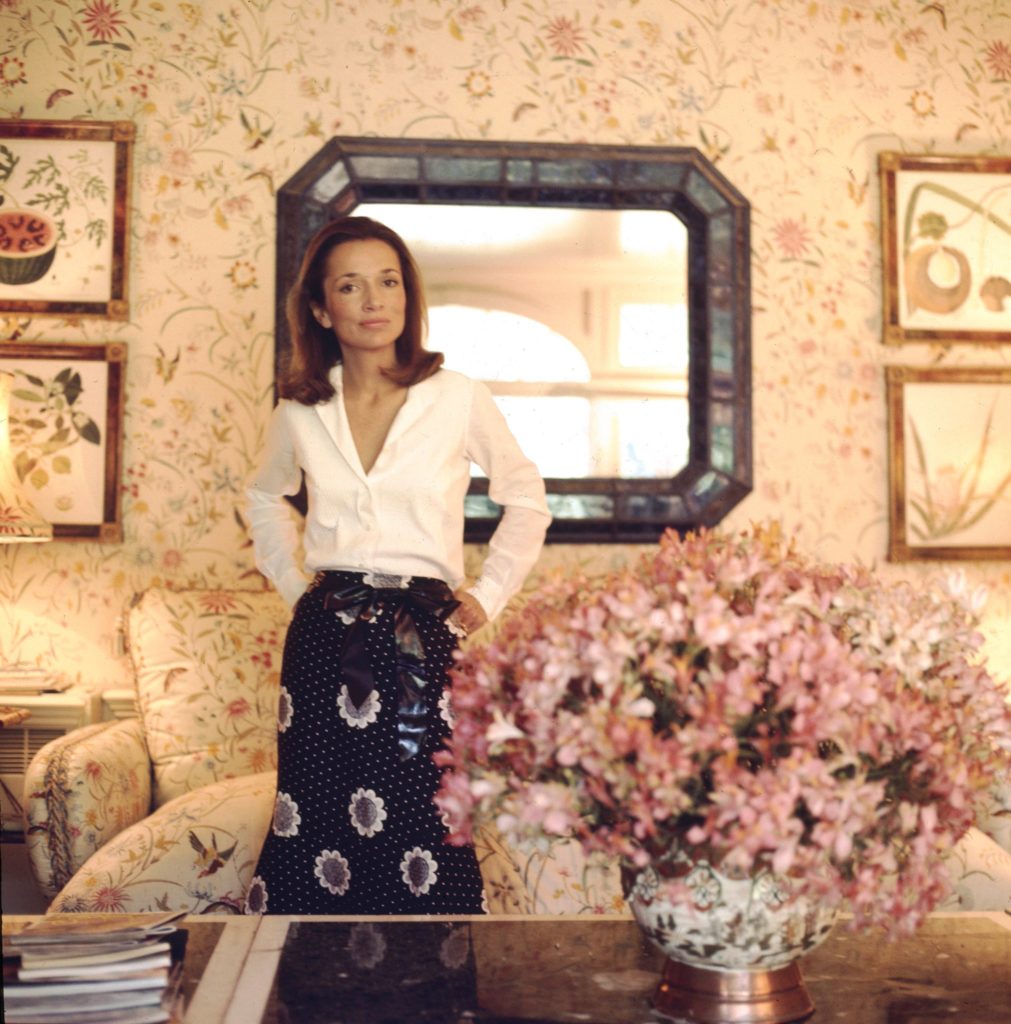
Talking about the country house and Renzo Mongiardino in her book Lee she says, “It was no palazzo, just something to amuse him. I had bought four yards of eighteenth-century fabric just because it was so beautiful. Renzo copied the rest for the living room exquisitely – even better than the original. Renzo was so easy to be with. His eye was extraordinary, and I learned so much from him.”
Mrs. Radziwill and the house were photographed by Horst P. Horst for Vogue in 1971.
 “The room between the living room and the library was a room of birds where Pedro, the parrot, and Samba, the toucan, hung in large brass cages.”
“The room between the living room and the library was a room of birds where Pedro, the parrot, and Samba, the toucan, hung in large brass cages.”

“Turville was a house of flowers. When you entered, it had a smell of straw rugs and burning fires mixed with the scent of sweet flowers. Each room was covered with them, whether it was the silk panels in the living room, picked out and bordered in the colors of Cantonese enamel with pale green and pink flowers, or the dining room, strewn with them painted over Sicilian scarves on the walls.”

The family spend every weekend, holiday, and part of the summer at Turville Grange. It was only an hour drive from London and the house was always full of guests.

This is the first time we see the botanicals that would become famous in her various homes. The set of 15 British-Indian botanical watercolor prints from the 19th century were a present from the Duke of Beaufort. She later hung them in her Paris apartment and after it was sold, they were gifted to designer Tory Burch who had long admired them.
You can read more about the botanicals here.

In the dining room, artist Lila di Nobili painted climbing vines and pastel blooms on the walls on which she had pasted beautiful Sicilian scarves. “When Henry Ford II bought the house we couldn’t take them with us.”

Tina and her cat in the flower cutting room.

George Oakes of Colefax & Fowler worked on the house and I’m sure he painted this pattern on the bedroom floor. Bunny Mellon also hired Colefax & Fowler to work on the townhouse that she and Paul Mellon had bought on East 70th Street in New York in 1966. Because John Fowler didn’t want to travel, artist-decorator Paul Leonard and his business partner, William Strom, executed the design and were taught the floor painting technique according to Michell Owens in Decorating with Painted Floors on Architectural Digest.com.
The pattern has become synonymous with Benny Mellon but Lee Radziwill uses it again in one of her New York apartments. Bunny was a very close friend of Jackie’s so I wonder if she traveled to England and saw Lee’s house or if Colefax & Fowler just suggested the floor to each woman without their knowledge. 
You can see how Tory Burch’s house in Southampton was very influenced by Turville.

In Happy Times, she write, “Stas was responsible for the indoor pool, which was a brief walk from the house in a low brick building with a lead roof in the middle of the orchard. It was very dramatic.” But in Lee she says, “Stas insisted on building an indoor swimming pool, which was hideous bu he enjoyed it.” That’s some shade.

“Lee Radziwill stretched out in field with her two dogs at Turville Grange near Buckinghamshire.” Photographed by Horst P. Horst for Vogue in 1971.
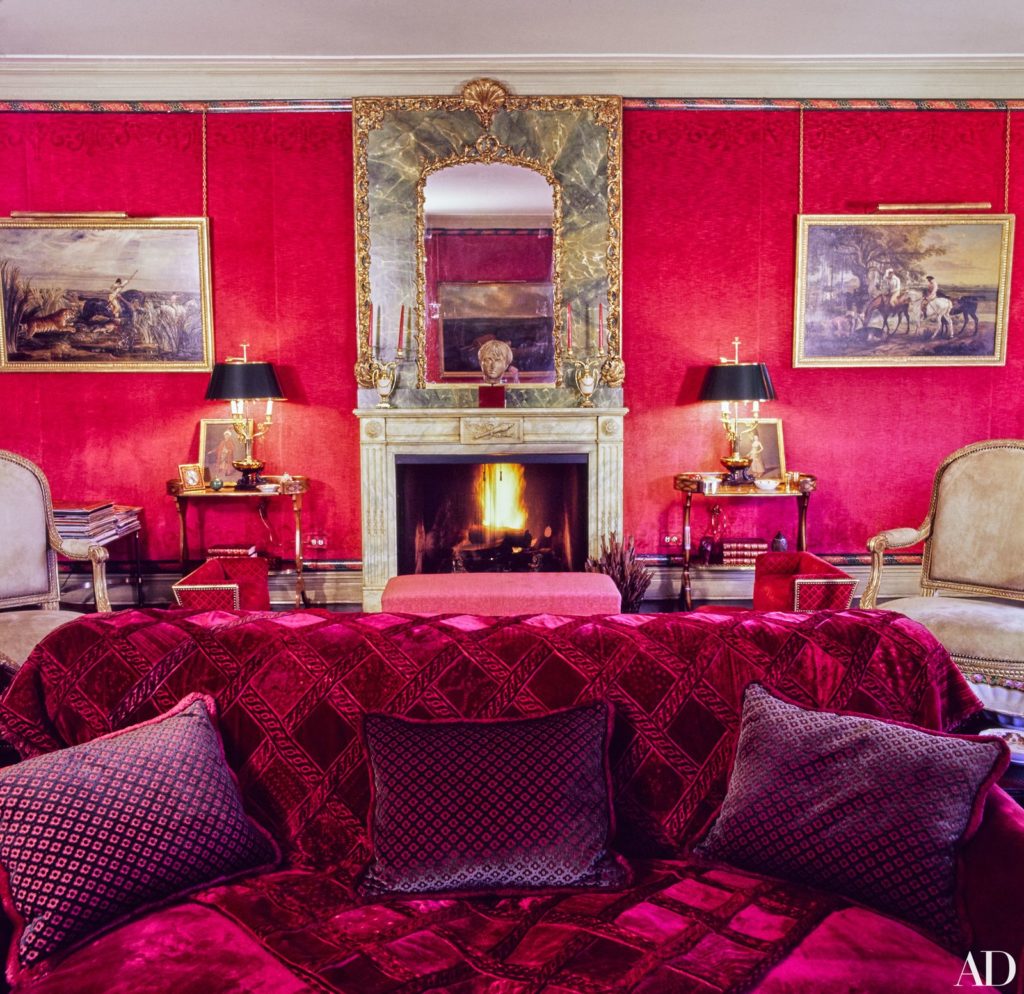
969 Fifth Avenue, New York – Approximately late 1960’s to late 1970’s
In Happy Times, Lee writes, “Jackie moved to New York in 1964, and Robert Kennedy persuaded Stas, who hated the city, to buy and apartment there, so I could be near her at least part of the year. Stas didn’t like the idea at all, and no one except Bobby could possibly have talked him into it.”
“I found the perfect apartment at 969 Fifth Avenue, and made it into a place I loved. Soon the children were in school there.”

“A series of three 19th-century English paintings by James Ward tells a tale of boar hunting in India. Louis XVI side chairs were designed by Georges Jacob. A fifth-century Roman head regards the calm, sophisticated scene from the mantel.”

“Although I had two of the prettiest houses in England, I wanted my children to feel closer to New York and to their cousins, and I wanted to be near Jackie and spend more time there. It was where I was happiest. The rhythm was different then. Life was more gentle.”

“Everyone had more time to relax, appreciate looking at things and visit museums. It was normal to lunch at people’s apartments rather than in a restaurant; and some, like Pamela Harriman, always made it feel like a special occasion in a warm and welcoming atmosphere with several guests.”

“The apartment was a duplex overlooking the trees of Central Park and the pale green leaded roof of what is now the New York University of Fine Arts. As it was in a dilapidated state, we gutted it completely. I asked Renzo Mongiardino to imagine the living room, and he chose a beautiful cheery-red velvet, which he stenciled very subtly and surrounded with re, black lacquer and gilt frames. The curtains were lettuce green taffeta with a border of woven colored velvet to tie in with the large Bessarabian rug.”

“Dark orange moiré covered the dining room walls, with a particularly amusing painting of a monkey shaking hands with a dog.” From AD, “A friendly dog in an 18th-century English painting by John Wootton surveys the moire fabric-upholstered dining room. A lily-bedecked epergne adds a bright touch to the mellow Regency furniture.”

Lee was photographed in the dining room in 1977.
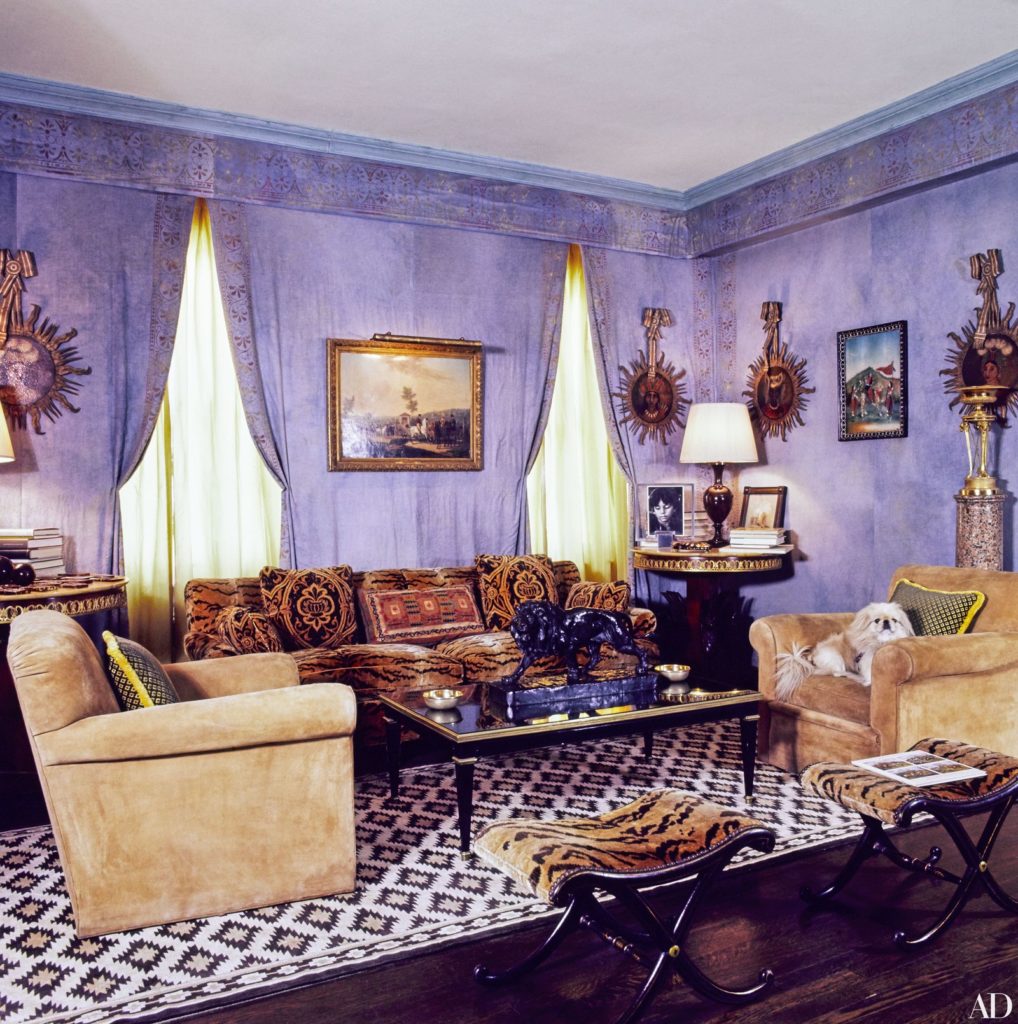
The Fifth Avenue apartment was featured in the July/August 1975 issue of Architectural Digest and has been reprinted here. To be honest, this is my least favorite of her homes except for the bedroom which is just gorgeous.
From AD, “Generously adapted French fabrics on the walls, windows, upholstered pieces and Regency benches suffuse the library with alluring and comforting quality. Paintings on tole depicting the four seasons and a tortoiseshell card case collection on the table at left are elements of an engaging personal style.”
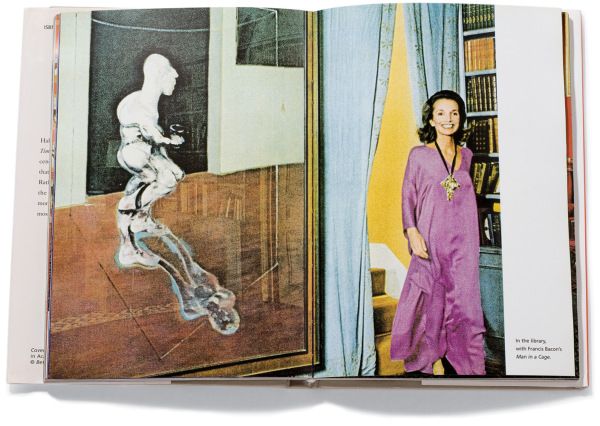
“In the hall library hung a Francis Bacon of a man in a cage, which Stas had acquired by paying Francis’ gambling debts. Jackie gave me beautiful bound sets of Balzac and Voltaire.”
Peter Beard remembered about this painting, “And talk about Lee’s flair for brilliant surroundings: the door opened onto one of the seriously great Francis Bacon paintings, collected early in the 1950s, before Bacon was really known, and well before I actually introduced him to Lee. (Bacon, by the way, thought she was great, too.)”
Peter Beard also said, “Bernard Berenson was a mentor during Lee’s early life, and she liked to quote the advice that he gave her to go for “whatever is life enhancing.” And actually that sums up Lee Bouvier Radziwill everything was life enhancing.”

“I wanted my bedroom to resemble a greenhouse as much as possible, with pale green and white color scheme which gave it a very airy feeling. I filled it with large ferns and hung Anglo-Indian botanical watercolors on the walls. When I woke up, I felt like I was in the country.”

As I mentioned earlier, Lee gifted the botanicals to Tory Burch who always admired them. She obviously also admired the design of Lee’s Fifth Avenue bedroom since she practically recreated it in her Southampton home. She even chose the same Colefax & Fowler Fuchsia fabric but in the blue chintz colorway instead of the original red chintz. I actually don’t blame her. I wouldn’t mind copying this room myself some day. Did you notice that both rooms have patterned painted floors too?
Tory’s Fall/Winter 2018 collection “was inspired by the interiors of Radziwill’s homes, in particular the Paris apartment where she once kept the watercolors, hung above a pink silk couch.” She even named a bag the Lee Radziwill Satchel and a floral print Happy Times after Lee’s book.

From AD, “An array of leafy 19th-century botanical prints and a delicate chintz fabric in the master bedroom add naturalistic life and color. A canopied bed, Venetian desk and voyeuse are all unselfconsciously painted.”

“Detail of master bedroom points up a daffodil and antique decoupage lamp next to a cherished family photograph on a bedside table.”

Another view of Tory Burch’s Southampton bedroom. Tory said on her website, “I have long admired Lee. She personifies elegance. Lee is fearlessly herself, and to me, that is always in style.”

Radziwill began an interior design consulting business from her Fifth Avenue apartment in 1976.

Tina’s bedroom included some of the botanicals.

Lee and Tina photographed in Tina’s bedroom.
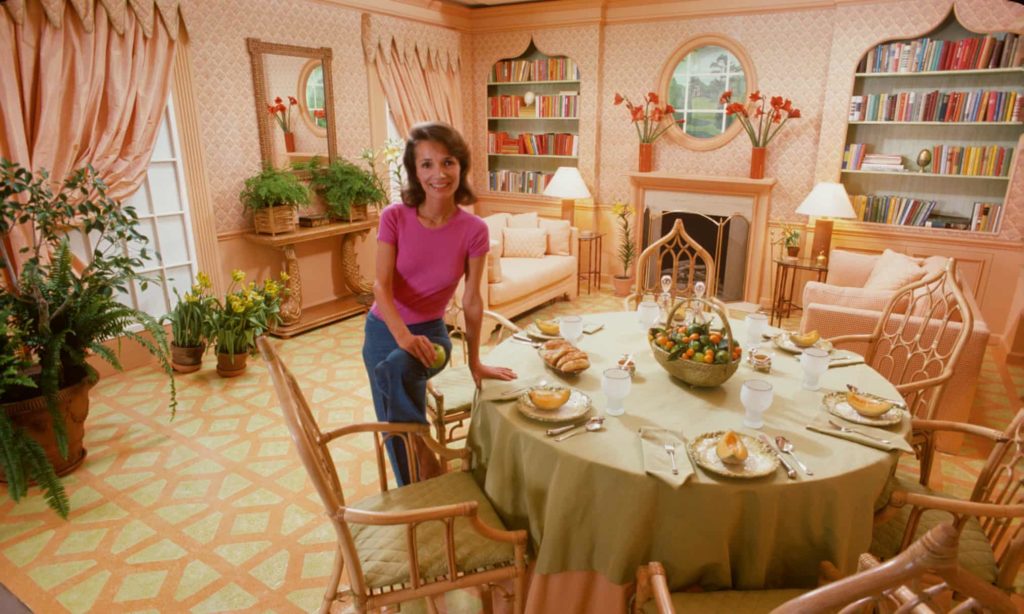
The caption for this photo says “Lee Radziwill in her dining room in March 1976” but it might have been one of her interior design projects.
 Park Avenue Penthouse – Approximately mid to late 1970’s – ?
Park Avenue Penthouse – Approximately mid to late 1970’s – ?
Lee had separated from Stas around 1971 and their divorce was final in 1974. She’s photographed in the Fifth Avenue apartment in 1977 so she might not have moved into this Park Avenue apartment until late 1970’s but I’m not sure.
“When the children were older, I moved into a charming penthouse on Park Avenue, which had an entirely different feeling, even though it was only two blocks away. It was more like Turville, in that all the fabrics, on the walls were strewn with flowers, giving it a country feel, with French doors opening onto the terrace. I used most of the same furniture so it had an echo of the past. It was lovely, but I missed Anthony and Tina a lot.”
The Regency dining table and chairs moved from the Fifth Avenue apartment to the Park Avenue apartment.

The Park Avenue penthouse was published in Architectural Digest in January 1982. I just ordered a set of AD issues from 1982 on eBay so I can read the article.

Mitchell Owens of Architectural Digest reminisces on the times he interview Lee Radziwill about her homes here.

This really is one of her loveliest homes. It’s light and airy and looks relaxing.

While many people design bedrooms in soothing shades of blue, I think it’s interesting that Lee had green bedrooms. This is the same bed from her Fifth Avenue apartment.
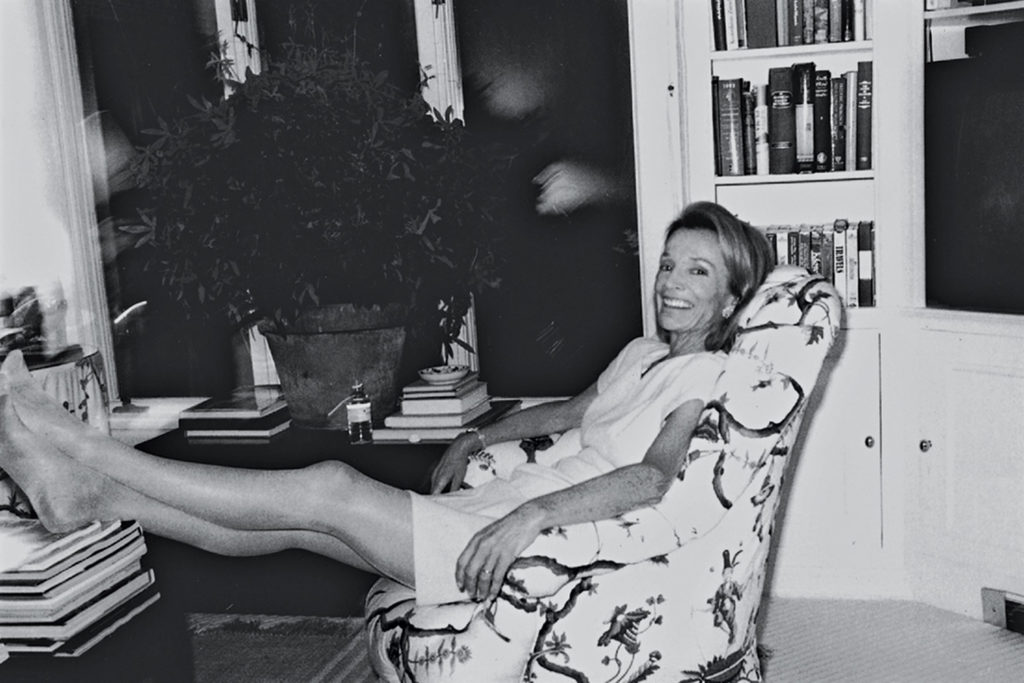
East Hampton, New York – ? to 2001 when it was sold
“Lee feeling happy and relieved in her house on East Dune Lane in East Hampton, after her son Anthony’s wedding to Carole DiFalco in 1994.”
There are some photos of the East Hampton garden at the end of her book Lee. It was almost sold to comedian Jerry Seinfeld in 1999 but ended up selling in 2001 to a financier who had rented the home in the summer. It had a bad fire in 2013 and later had to be rebuilt.
In 1988 Lee married film producer Herbert Ross and they divorced in 2001. There is evidence of addresses in Los Angeles but I haven’t seen any of these homes. I’m also not sure where she lived after the divorce. Perhaps she had kept the Park Avenue Penthouse.

Paris Apartment No. 1
Paris was one of Lee’s favorite places and she once said, “When you see some sun, Paris is the most beautiful city in the world. It brings tears to your eyes.”
In April 2009, Elle Decor published photos of Lee’s Paris apartment and her last New York apartment on East 72nd Street.
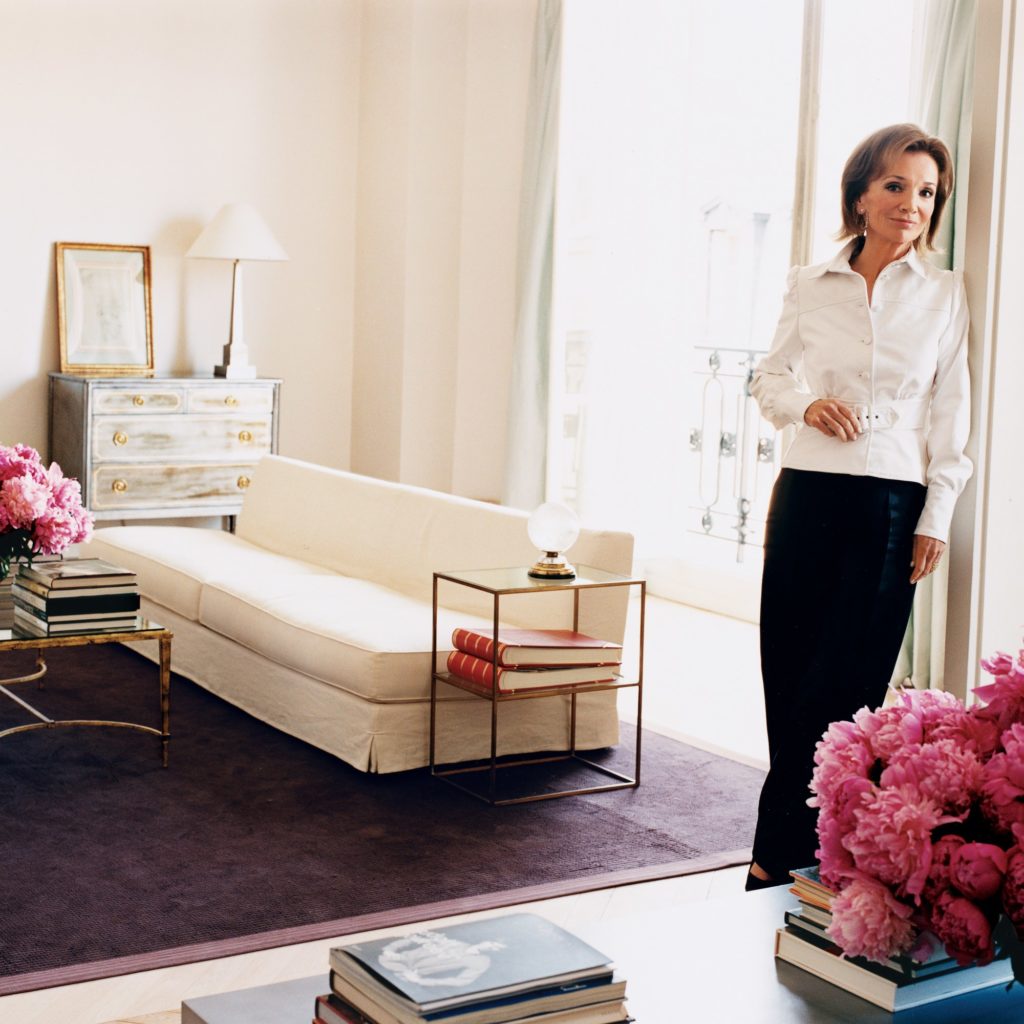
The photo above has a pale interior unlike the apartment in 2013. She also has a different hair style so this photo might have been taken well before the 2009 shoot.
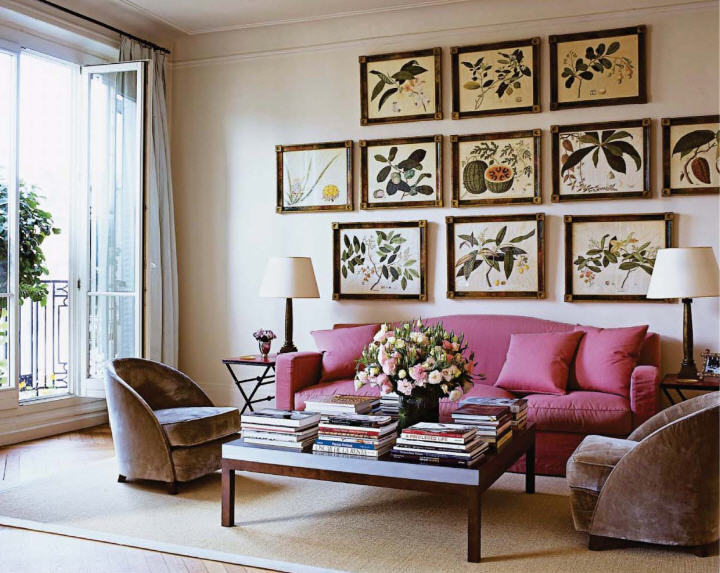
In 2009, the botanicals are present and velvet chairs flank the pink sofa and coffee table.

In 2009, the library walls, curtains, and upholstery are all clad in a Le Manach fabric. These chairs end up in the living room in 2013 so it might be because she didn’t recreate this room in the new apartment.
On the wall is a photograph by Peter Beard, one of her lifelong friends. She talks about still getting Christmas cards from him in the 2013 video on T magazine when she’s interviewed by Sofia Coppola. Sofia also said in an interview, “She told me her greatest romance was with Peter Beard in Greece one summer, when he was teaching art to her niece and nephew. That ended her marriage, but how great to have that be your romantic summer fling?”

It’s a little blurry but you can see the kitchen from Elle Decor in 2009. The table is set with antique Limoges china.

The same furniture from her bedroom in 2009 ends up in the 2013 apartment.
 Paris Apartment No. 2 – ? to 2017 when it was sold
Paris Apartment No. 2 – ? to 2017 when it was sold
In 2013, the Paris apartment overlooking the Avenue Montaigne has a very similar long layout to the apartment in 2009 but just reversed with the french doors on the opposite side.
Sofia Coppola told a funny story, “One of my most vivid memories of Lee is visiting her apartment in Paris with my young daughters for tea. Romy was 4, and Lee gave her a plate of brownies and pastries. I was terrified of a hyper kid surrounded by cream furniture and toile, and Lee, in a perfectly calm voice and a smile, said to her, “Romy, I will just kill you if you get chocolate on my chair.” They have been friends ever since.”
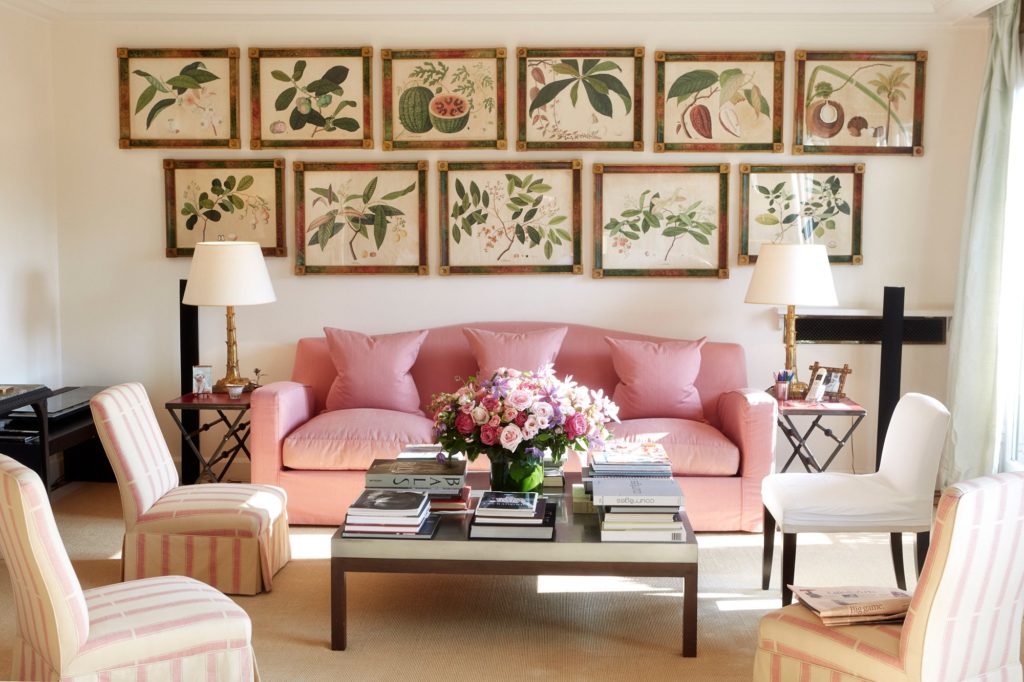
In 2013, upholstered slipper chairs flank the pink sofa. She must have entertained frequently.
Jeffrey Bilhuber said in an interview about her taste, “She’s the only American woman who innately understood French refinement, be it fashion, interiors, or men.”

I’m really surprised that Lee lived to be 85 when she smoked all her life but then again, Albert Hadley smoked every day and lived to be 92, so what do I know.

She told Hamish Bowles of Vogue in an interview, “I asked Christian Liaigre to help me achieve this extraordinary sense of calm. That’s what I feel. I don’t know what happened, but I lost the desire to acquire more things. It’s very peaceful to have lost that desire.”

You can see more of how the Paris apartment looked in the real estate photos in my post For Sale: Lee Radziwill’s Paris Apartment.
She said that “Paris is life-enhancing for all those reasons we know and all those words that have become so banal.”
She sold the apartment because she didn’t spend as much time there as she used to and preferred to stay at the Plaza Athénée. I think travel also become harder in her later years as she used a wheelchair more and more.

Lee graces the cover of Bals: Legendary Costume Balls of the Twentieth Century in a photo from Truman Capote’s famous Black and White Ball. 
The master bedroom in 2013 was mostly unchanged from the 2009 version with D. Porthault linens.
Sofia Coppola remembers, “I got to know Lee through Marc Jacobs when I was living in Paris. She helped him pick out beautiful linens and dishes when he was setting up his apartment. Lee knew all the best places to go, and they got beautiful tablecloths at D. Porthault and silver at Puiforcat. Of course, she has impeccable taste and knows how things should be done.”
In a The New York Times article by Vanessa Friedman, says that Lee told Marc, “that his table service should not be monogrammed. “Oh no, darling, you never put your initials on anything, ever,” Mr. Jacobs remembered her saying — so he didn’t. She took him to what he called the best Art Deco gallery in Paris, and to the Opéra Garnier for the first time.”
“With her, everything was studied, everything was considered, even the way she smoked a cigarette,” Mr. Jacobs said. “But she had a terrific sense of humor. Her delivery was so chic.”

The view of the Eiffel Tower from the apartment in 2013.

160 East 72nd Street, New York, NY – ? to 2019
In 2009, Lee’s East 72nd Street apartment was featured in Elle Decor. This is the room in which Lee was interviewed by Sofia Coppola for T magazine in 2013 and looked the same.
The mirror from Felix Harbord from her London and Fifth Avenue homes sits over the fireplace. The sofas and ottomans were custom made by De Angelis. The rug is 19th-century and the Louis XVI chair is signed by G. Jacob and has also been used in other homes.

In the New York library, the walls, curtains, and sofa and upholstery is in another Le Manach fabric. That upholstered chair in the foreground was also seen in her Fifth Avenue bedroom.

The settee in the library is Swedish.

Lee took up watercolors and her work rests on the Art Decor chest of drawers. She also gave pieces to friends as gifts.

The dining room features 19th-century chairs and Milanese silk upholstered walls, shade, and tablecloth.

Lee designed the settee in the sitting room which is covered in a vintage Rubelli stripe that was also upholstered on the walls and used for the draperies and other upholstery.

The take away from looking at Lee Radziwill’s interiors is buy the best and you only cry once. Well made pieces last forever and can be moved from home to home and room to room and upholstered in new fabrics to suit your updated tastes.
“When I buy something, I do so with the intention of keeping it forever. I’m constantly falling in love with objects, and they follow me around the world.”
Caroline Lee Bouvier Canfield Radziwill Ross
3 March 1933 – 15 February 2019



